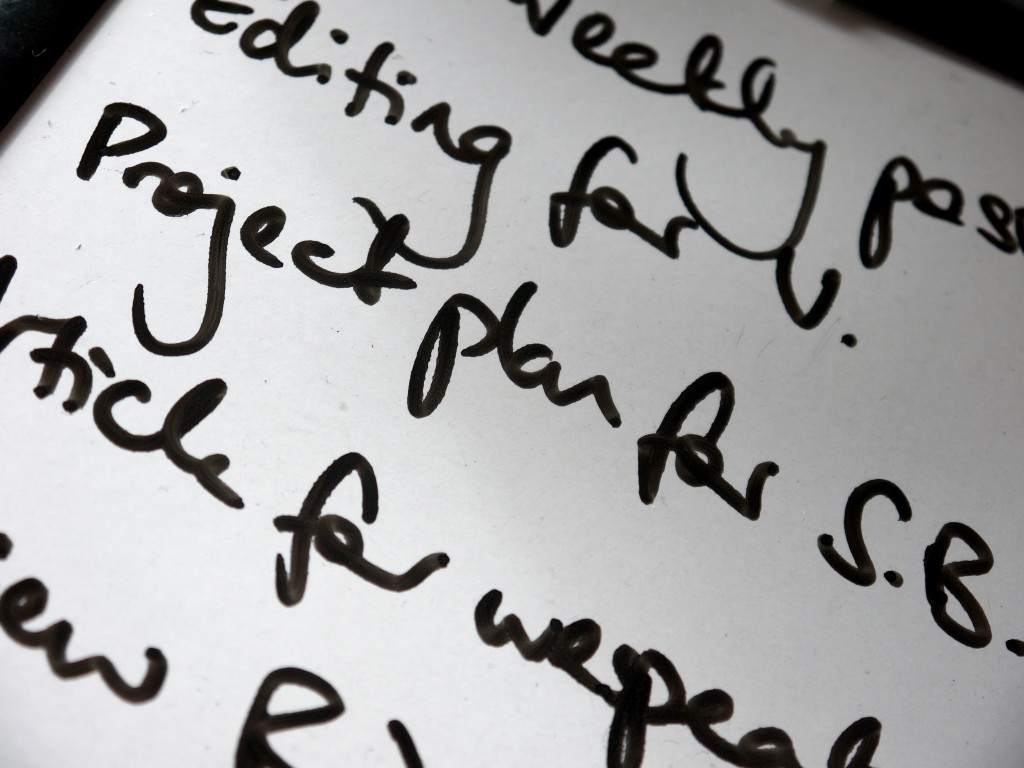
When it comes staying organized, whiteboards are about as old school as it gets– but they work. In this guest post, British freelance writer and WordCount Last Wednesday writer chat regular Philippa Willitts explains how. — MVR
As a freelancer, I constantly looked for ways to streamline the writing process. But I could never stick with a method; each one I tried failed. Paper to-do lists became overwhelming, computer to-do lists were slow to load, and spreadsheets got so complicated I abandoned them.
Because running a freelance business requires quite exceptional organizational skills, I had to find something.
So when I came across a whiteboard in Poundland — think Dollar Store with a different exchange rate — I bought it. To be honest, I expected it to be another ingenious idea I would use for two, maybe three weeks, before getting annoyed with its shortcomings and looking for the next solution.
As I started using it, I realized that this method would stick. It was adaptable, I could see at a glance what I was supposed to be doing, and it was quick and easy to add new tasks and remove old ones. Rather than getting annoyed with it after a few weeks, I found myself relying on it more and more. I was a whiteboard convert.

I’m not the only one in love with whiteboards. Today they show up in aspirational home office photographs on Pinterest. If buying one is too expensive, you can make your own.
Here are a few things to know about whiteboards:
Small boards work just as well as large ones. My whiteboard is small, just larger than a piece of A4 paper. Its small size means my lists have to remain a manageable length, unlike lists I make on a paper notepad, which could go on indefinitely. If the board gets full, I either finish some tasks, or decide which aren’t important after all, and erase them.
Keep it close. Using a whiteboard means my work priorities are always visible. I keep mine just to the left of my computer screen. I respond well to visual cues, so if important deadlines are on the whiteboard I don’t overlook them. Colorado science writer Christie Aschwanden also whiteboards to track what she’s working on. Talking to The Open Notebook about why she uses one, she explains, “I like to map things visually, it helps me see what I have”.
Use it to map projects. Speaking of mapping, if you’re planning a big project like an outline for a book or structure for a website, a larger whiteboard allows you to mind map it. It can be altered at any time, and the whole plan acts as a visible reminder.
Use it to schedule yourself. Oregon freelancer Jennifer Willis uses a whiteboard that is divided into days of the week. At the start of each week, she arranges upcoming tasks and schedules them onto the board. Willis likes the immediacy. “It’s always right there, without my having to launch an application or navigate between screens,” she says. “It also gives me a peaceful feeling of organization and of being in charge, rather than being reactive. There’s something very satisfying about physically crossing items off the whiteboard list as I complete them.”
I normally embrace all things technological. But sometimes I surprise myself by rediscovering how effective a pen and a big piece of paper feel for planning and organization. Whiteboards take that one step further. I can’t fault my little, bargain whiteboard for making day-to-day work life considerably easier.
Philippa Willitts covers health and disability, women’s issues, social media and SEO. On Twitter, follow her at @PhilippaWrites.
I’ve used a whiteboard in the past and found that for some reason, I just wasn’t keep it updated. However, I loved some of the photos you linked to on Pinterest and your suggestion to keep the whiteboard small to keep the number of items on it manageable. Maybe I need to give whiteboards another chance!
Susan: I’m not a whiteboard user either, but this post and the comments have me thinking I should reconsider.
Michelle
I’m glad I gave you pause for thought! It could well be worth a try, and they really needn’t be an expensive purchase.
I use a rather big whiteboard, hanging on the wall directly opposite my desk, to map out upcoming submissions, queries, and deadlines. There’s something quite satisfying about seeing it there, crossing out, adding in, etc. And, I love having 5 different colored markers to use. Sometimes low tech = high reward!
Different coloured markers is a great idea. I was in a stationery shop a few days ago and they were even selling whiteboards in different colours (blueboards and purpleboards, I guess!).
Nice job! I love my whiteboard. . .
I’m not alone, then! I have several whiteboards, and have been known to have a different whiteboard for each project. I also have a tiny one, about 4×6″, with an easel on the back that I use to list phone calls or immediate tasks.
Best thing about white boards: I believe that there is an endorphin release when I erase a task!
I’ve also used Levenger card racks on my desk with similar success–low tech, quick, and effective!
But, like you, I rarely stick to a system and love coming up with a new one!
I love the idea of a tiny whiteboard on an easel! And yes, wiping something away is an amazing feeling!
Yes! I love whiteboards – I have a small one pinned up over my desk and it’s brilliant, particularly for what Philippa describes about doing the jobs on the list of erasing them to make way for others. It’s a brutal but effective way of prioritising.
From the response that this post has received — and the page views — I’d say you’re in good company.
Michelle
Thanks Lorrie! (My podcast partner!)
Yes, I think the prioritising aspect, as well as the visual aspect, are what makes whiteboards so successful to motivate me and keep me on top of my work. I can’t get overwhelmed, and I can always see what I’m supposed to be doing.
I’m a little bit biased, but having a larger whiteboard can really come in handy – even if it’s just for sectioning off and using parts of it for different purposes. Having the ability to use the entire large area can really come in handy for brainstorming or the occasional large project.
I would like to invite you and your readers to have a look at my companies Dry Erase wall covering, Opti-Rite. The material comes in a roll and sticks to the wall with a self adhesive backing. The writing surface is as good as any other dry erase surface on the market (it is even guaranteed to erase!)
For more information or to request samples visit http://mywhiteboards.com/optiritelight.html